Bangladesh, India, Pakistan: economy, development
This is a collection of articles archived for the excellence of their content. |
Contents |
Bangladesh, India, Pakistan: comparisons
Health, literacy, life expectancy: 1950-2020

From: February 2, 2022: The Times of India
See graphic:
Health, literacy, life expectancy in Bangladesh, India, Pakistan: 1950-2020
As in 2017-19

From: August 15, 2020: The Times of India

From: August 15, 2020: The Times of India

From: August 15, 2020: The Times of India
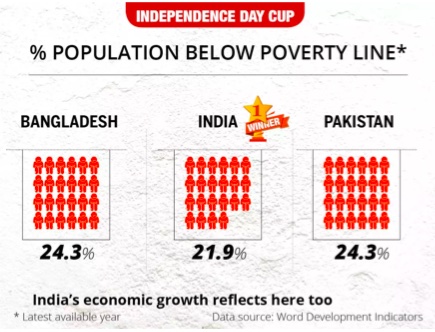
From: August 15, 2020: The Times of India
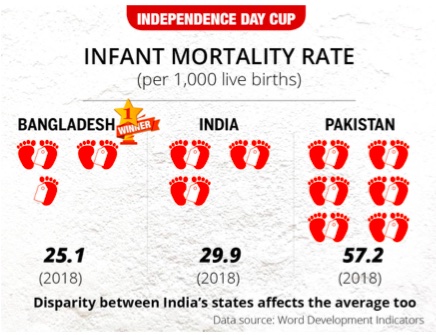
From: August 15, 2020: The Times of India
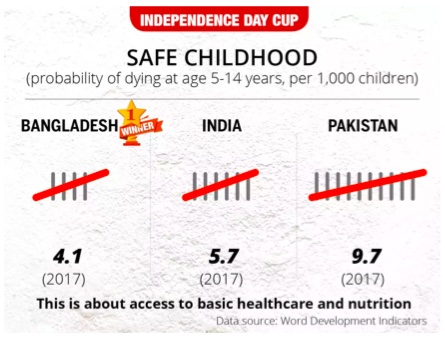
From: August 15, 2020: The Times of India
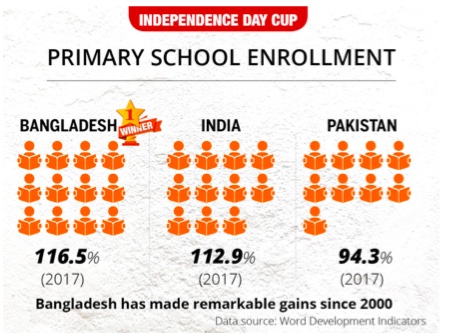
From: August 15, 2020: The Times of India

From: August 15, 2020: The Times of India
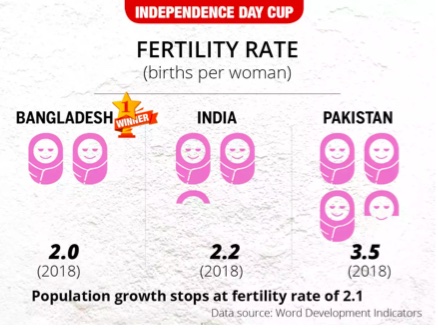
From: August 15, 2020: The Times of India
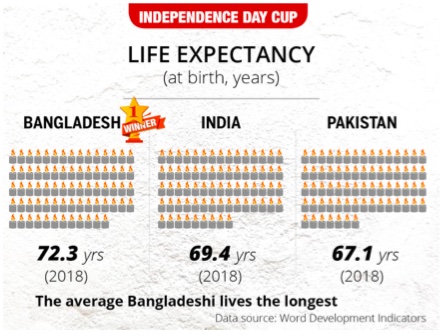
From: August 15, 2020: The Times of India
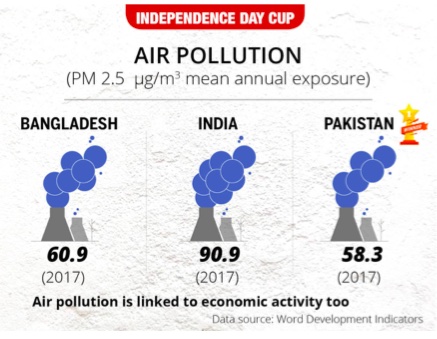
From: August 15, 2020: The Times of India

From: August 15, 2020: The Times of India
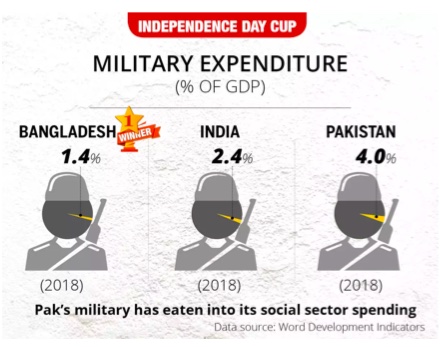
From: August 15, 2020: The Times of India

From: August 15, 2020: The Times of India
See graphics:
Bangladesh vis-à-vis India vis-à-vis Pakistan- GDP per capita, as in 2019
Bangladesh vis-à-vis India vis-à-vis Pakistan- GDP, as in 2019
Bangladesh vis-à-vis India vis-à-vis Pakistan- Ease of Doing Business, as in 2019
Bangladesh vis-à-vis India vis-à-vis Pakistan: % population below poverty line
Bangladesh vis-à-vis India vis-à-vis Pakistan: Infant Mortality Rate, 2018
Bangladesh vis-à-vis India vis-à-vis Pakistan: Probability of dying at age 5-14 years, per 1000 children
Bangladesh vis-à-vis India vis-à-vis Pakistan: Primary school enrolment, 2017
Bangladesh vis-à-vis India vis-à-vis Pakistan: Literacy Rate 2018
Bangladesh vis-à-vis India vis-à-vis Pakistan: Fertility Rate 2018
Bangladesh vis-à-vis India vis-à-vis Pakistan: Life expectancy 2018
Bangladesh vis-à-vis India vis-à-vis Pakistan: Air pollution 2017
Bangladesh vis-à-vis India vis-à-vis Pakistan: Access to electricity 2018
Bangladesh vis-à-vis India vis-à-vis Pakistan- Military expenditure 2018
Bangladesh vis-à-vis India vis-à-vis Pakistan- Achievements and scope for improvement in performance
2021
Rema Nagarajan, July 13, 2022: The Times of India
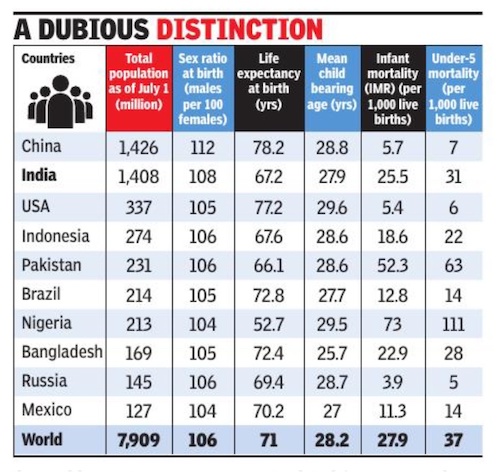
From: Rema Nagarajan, July 13, 2022: The Times of India
India is poised to overtake China as the world’s most populous nation, but it is third from the bottom on most development indicators among 10 most populous countries, with only Pakistan an d Nigeria consistently below it. In fact, when it comes to sex ratio at birth, India is second from the bottom with just China recording a worse gender skew.
Bangladesh performs better than India on most parameters tracked by the UN’s World Population Prospects 2022, but is worse in one of them. Only one of the ten, the US, is a developed economy while four others — Russia, Brazil, Mexico and China — are categorised by the UN as upper middle-income. The rest are all in the lower middle-income bracket.
When it comes to the mean age of child bearing, Bangladesh has the lowest mean age among the ten countries. While India’s indicators are worse than the global record on most indicators, it has brought down its infant and under-5 mortality rates below the world average.
Lower life expectancy at birth is m ost often because of high infant and under-five mortality. However, in the case of countries like Indonesia, I ndia and Russia, even at 15 years, life expectancy is just 54. 4, 54. 7 and 54. 9 respectively. Similarly, a person who managed to reach 65 years of age can expect to live just 12. 7 m ore years in India and just 12. 1 m ore in Indonesia. These are the lowest barring Nigeria (11. 1).
Incidentally, among these 10 countries, Bangladesh is the most densely populated, 1,301 per sqkm , followed by India (473. 4 per sq km) and then Pakistan (300. 2 per sq km). Russia is the least densely populated, just 8. 9 per sqkm.
While differential income levels among the ten most populous countries could explain a lot of these patterns, the fact that Bangladesh with significantly lower per capita GDP based on purchasing power parity (PPP) than India, $6,613 compared to India’s $7,333. 5, has done better on most parameters shows it’s not all just about how rich or poor a country is. Nigeria with the lowest per capita GDP based on PPP in this group, just $5,459. 2 and Pakistan with $5,877. 6 have the worst indices. Though Indonesia figures in the lower middle-income category, its per capita GDP based on PPP is $12,904. 3, well above the others.
Pakistan vis-à-vis India
1960-2015, 2020
November 27, 2020: The Times of India

From: November 27, 2020: The Times of India

From: November 27, 2020: The Times of India

From: November 27, 2020: The Times of India

From: November 27, 2020: The Times of India
India vs Pakistan: A tale of two economies
NEW DELHI: India and Pakistan — two of the biggest South Asian nations — started their economic journey around the same time after gaining Independence. Not many know that there was a point in the 1960s when Pakistan's per capita GDP used to be higher than that of India's. However, over the years, India has not only surpassed Pakistan's per capita GDP but taken a commanding lead on almost every economic front.
Pakistan today is facing global criticism for failing to rein in homegrown terror groups even as it grapples with an ailing economy and mounting global debt. India, on the other hand, has become a global frontrunner which recently surpassed the UK to become the fifth largest economy in the world. The stark economic contrast between the the two neighbours shows that Pakistan's unstable government, conflicting power centres, covert support to terror groups, and involvement in global terror strikes such as the 26/11 Mumbai attacks, have bled its economy.
Here's a look at the economic performance of the two nations:
- India is today the fastest growing trillion-dollar economy in the world and the fifth largest overall, according to data compiled by IMF's World Economic Outlook. It jumped from the 9th spot in 2010 to the 5th spot in a span of just nine years. the GDP of India is almost 10 times that of Pakistan, which is placed at the 45th position.
- India's rise has been even more dramatic across the past couple of years. Since 2008, its GDP has risen almost 140 per cent as against an increase of about 63 per cent for Pakistan.
- According to World Bank estimates, in 2019, India's GDP (current $ terms) was $2.875 trillion while that of Pakistan was $278.22 billion.
- In terms of purchasing power parity, India ranks third globally with a GDP of $9.612 trillion in 2019 while Pakistan is at 24th spot with GDP of $1.058 trillion.
- In World Bank's ease of doing business ranking 2020, Pakistan stands at 108 position while India is placed higher at th 63rd spot.
- India’s post-independence journey began as an agrarian nation. However, the manufacturing and services sector have emerged strongly over the years. The service sector is the fastest-growing sector, contributing to more than 60 per cent to its economy and accounting for 28 per cent of the employment. Manufacturing remains as one of its crucial sectors and is being given due push via the governments' initiatives, such as 'Make in India'.
2018-20
January 16, 2022: The Times of India
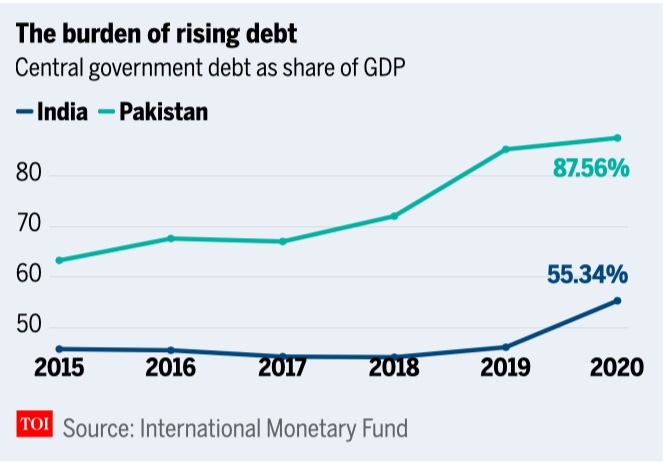
From: January 16, 2022: The Times of India
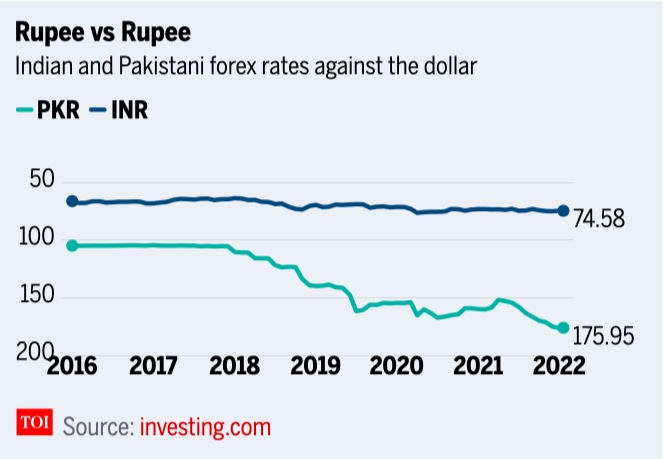
From: January 16, 2022: The Times of India

From: January 16, 2022: The Times of India
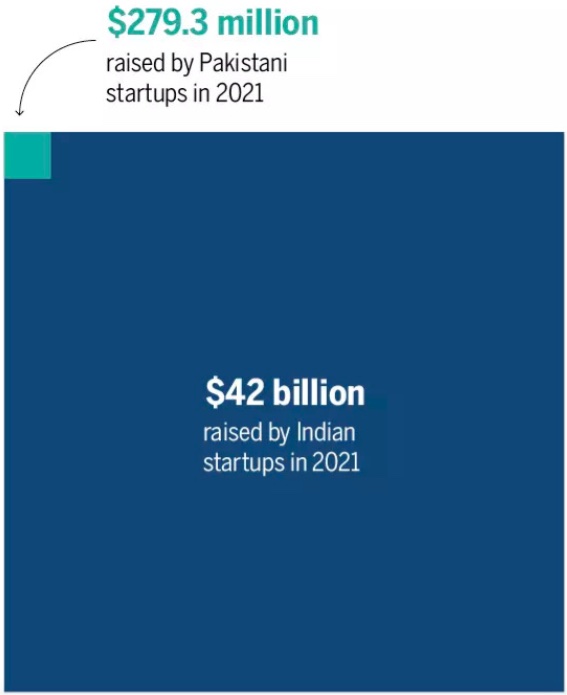
From: January 16, 2022: The Times of India

From: January 16, 2022: The Times of India

From: January 16, 2022: The Times of India
See graphics:
The burden of rising debt on India and Pakistan, 2015-20
Indian and Pakistani forex rates against the dollar, 2016-22
Top 5 with the most billionaires, 2021-22
Amount raised by Indian and Pakistani startups in 2021
Incomes of cricket boards in current $, 2018-20
Share of unbanked population in 2021
He once blamed what women wear for the rising cases of sexual assaults. More recently, in a televised address he put India’s population at “one billion 300 crore.” On another occasion, he misquoted Ronald Reagan and that too in a UN address. Of course, he is not the only world leader not willing to let facts come in the way of a speech. He is also not the only world leader who thinks speaking extempore somehow enhances his appeal.
Thus, it is sometimes difficult to take Pakistan Prime Minister Imran Khan seriously, even if you worshipped him as a cricket fan. But then, he is the democratically elected leader of a big country and every word he speaks will be parsed for a meaning that may not be apparent or a signal one might just miss. And that is why when Khan the other day said Pakistan’s economy is stronger than India, it led to all kind of reactions, chiefly bordering on incredulity.
To Pakistan’s credit, its economy did look better than India's for a decade or so, but that was a long time ago. At this moment in time, Pakistan is a basket case of economic failure, while India, fumbling and tumbling in its own ways, is one of the most attractive markets globally. So, here are some sobering comparisons between the two economies for Imran Khan:
How much we earn
It’s not fair to compare the national incomes of India and Pakistan — ours is a far bigger and more populous nation. But what about per capita income in the world’s reserve currency, the US dollar? India’s economy has suffered the double whammy of a sudden demonetisation and the difficult implementation of a new tax regime in recent years. But even then, the average Indian pulls ahead of the average Pakistani by a fair margin. Interestingly, Pakistan’s average wealth was more than India’s till 2008. From then on, while the Indian economy grew in strength, Pakistan’s got bogged down. The relative weaknesses of the currencies also have had a telling effect on the dollar figures. Inequality? Well, that’s another story altogether.
How much we owe
Neither India nor Pakistan has an enviable record on managing national debt. And it’s a more worrisome picture when state and other government-related debts are piled on. But Pakistan’s debt management has gotten worse since Imran Khan has had a say in managing the purse — its debt is now close to its national income. India has had only two finance ministers since 2015, while Pakistan has had eight. This week, the International Monetary Fund called on Pakistan to renegotiate its loan programme if it intends to get a requested extension.
Currency capitulation
Both the Pakistani and Indian rupees have been battered against the dollar in recent years. In fact, the Indian rupee was the worst performer in Asia last year. But given the relative size, health, and capital flows of the two economies, Pakistan’s has suffered more over time. This means costlier imports and foreign travel. Exports would be a bit cheaper, but given that India’s exports make up less than a fifth of its GDP and Pakistan’s less than a tenth of its own, it does not help much. Pakistan’s access to foreign funds continues to be stifled because, since 2018, it has been kept on the Financial Action Task Force’s ‘grey list’ of jurisdictions that need close monitoring, mainly because of its inability to tackle terror financing.
Global economic prospects
According to the World Bank's ‘Global Economic Prospects’ released January 11, 2022, India's economic growth is expected to be 8.3% in the current financial year and 8.7% in 2022-23. Pakistan's economy will grow by 3.4% in this fiscal and at 4% in 2022-23.
Wealth creators
Forbes's list of billionaires by country puts India in the third spot with 140 billionaires. The US, by the way, has 724, and China 698 billionaires. While countries like Nigeria and Peru are placed in the 44th spot, Pakistan does not figure in the list.
Startups
2021 was Pakistan's best year ever for startups with a total investment of 279.3 million. India's startups, on the other hand, raised over $42 billion.
Of course, how can we forget cricket?
A large part of Imran Khan’s public persona rests on his stature as one of cricket’s all-time greats. But how do our two cricket-mad nations compare in managing the sport’s finances? The Board of Control for Cricket in India is the richest cricketing body in the world, far richer than the Pakistan Cricket Board. Back in 2007, PCB had threatened to sue BCCI to recover $200 million in lost revenues after India's refusal to play two home series in Pakistan. But it didn’t help when the Sri Lanka cricket team’s bus was fired upon by 12 gunmen in Lahore in March 2009. All cricketing nations stayed away from Pakistan for a decade and the financial repercussions of that are visible even today.
A caveat
One of the reasons why Pakistan’s economic indicators look so poor is the size of its informal economy. According to a recent Bloomberg report, Pakistan is one of the world’s most unbanked countries — with over 70% of its population outside its formal banking system.
Pakistan vis-à-vis Maharashtra, Tamil Nadu: 2004-2024
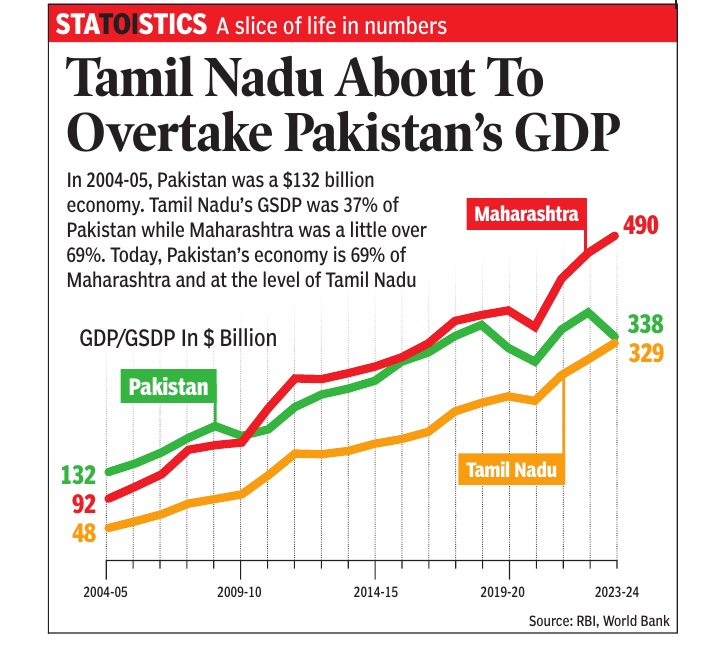
From: May 15, 2025: The Times of India
See graphic:
The economy of Pakistan vis-à-vis Maharashtra, Tamil Nadu: 2004-2024